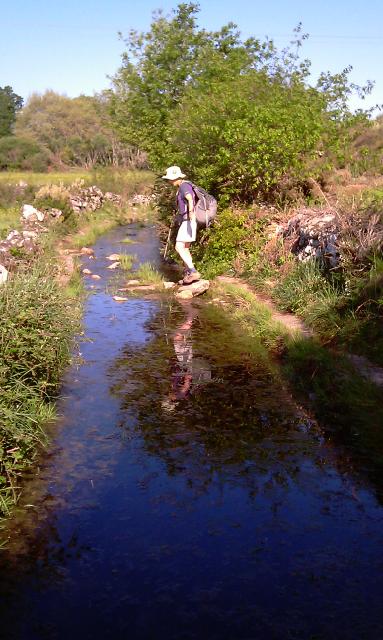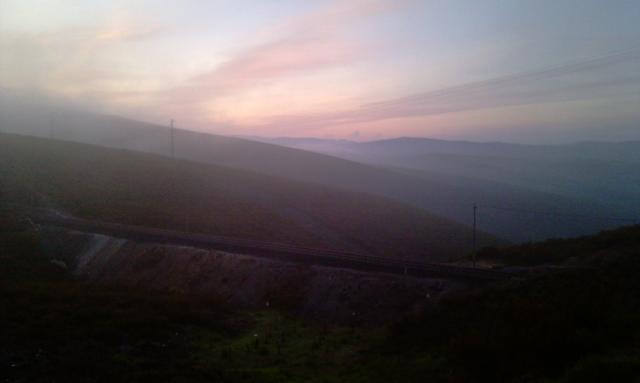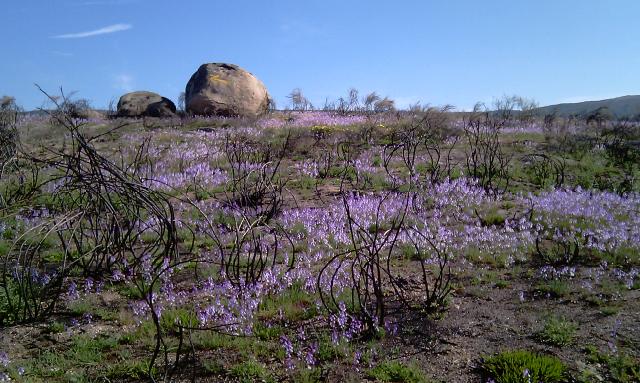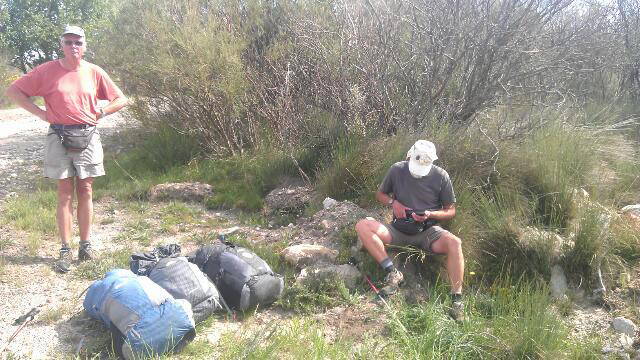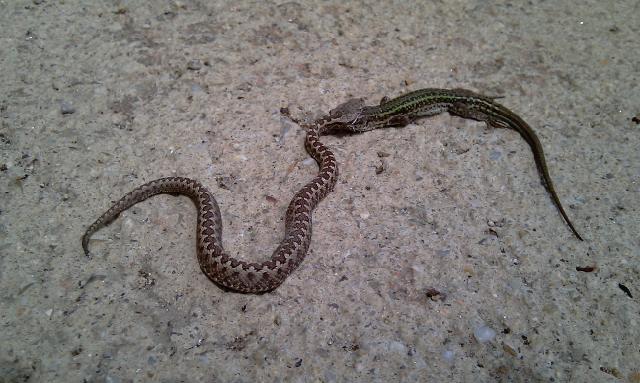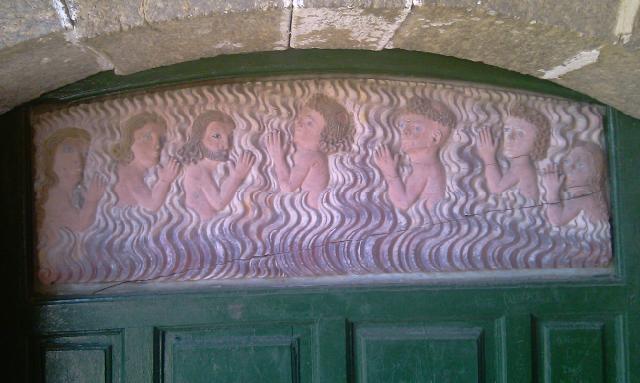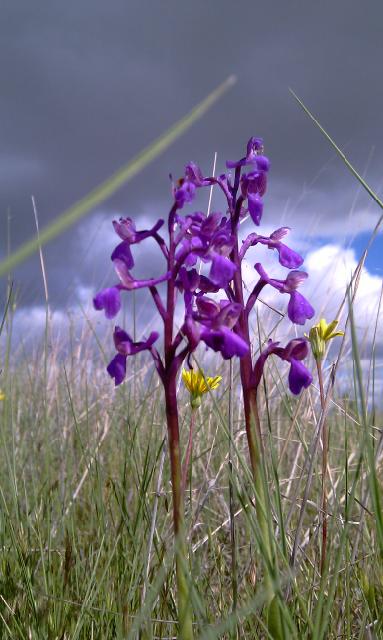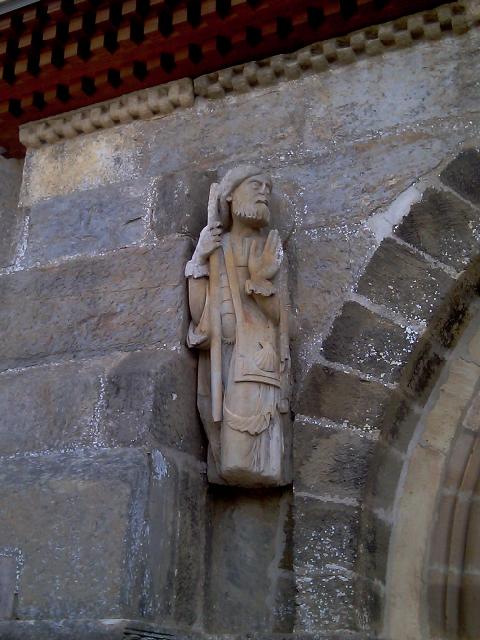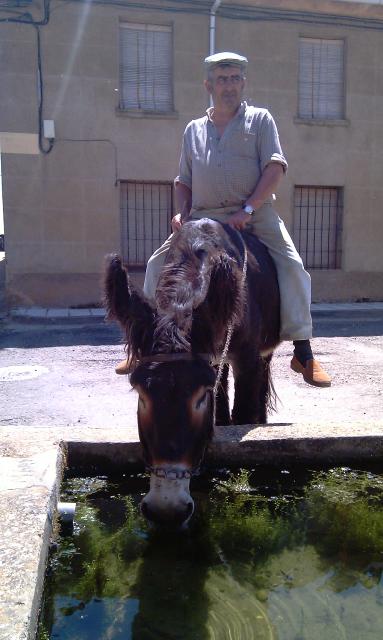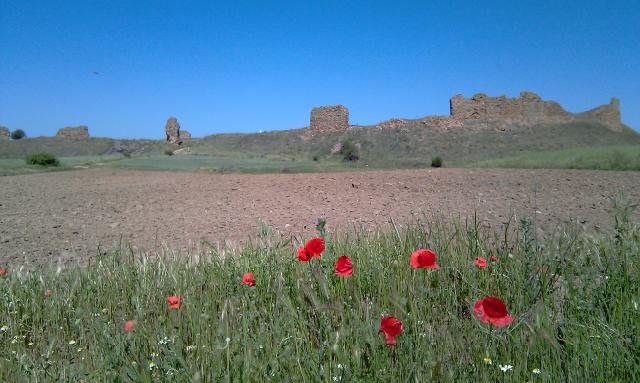31.5 Thursday. Lava to Villar de Barrio.
We have some choices about distances to walk over the next few days, there are some stiff climbs before Ourense and distances are awkward. We opt for the shorter distances and the extra days travel. One donkey is dozey.
So with only 20ish km to do we start late, about 6.30 after a disturbed night and none of us at our best. After a 4km amble up the valley from Laza during which we see a field of brilliant yellow lupins (wild or tame? impossible to tell), we start to ascend from the misty verdant fields up a steep slope into yellow gorse, heather and later young pine plantions. Views as the mist rises are fine and frequently admired (nothing to do with rests)!
We see two turtle doves and a rock bunting, eventually reaching Albergueria at about 900m from 450m in Lava on the valley bottom. This hamlet, now very depopulated once had a pilgrim hospital for those sick or injured on the Way. Now for a few years it has a private albergue and cafe at which it is customary to write one’s names, date and start on a scallop shell and it gets nailed to the ceiling. There is a fair amount of space left but filling rapidly!
Shortly after another stream takes over the path, Betsy nearly comes to grief on a large wobbly stepping stone. Tim, an admirer of Santo Domingo (the civil engineer of the medieval Camino Francais) stops to improve the way for some future pilgrims by wedging it more solidly. Probably not a work as durable as some of Domingo’s.
Another km or two and the route passes an old wooden cross and starts finally to descend to Villar de Barrios. The day is warming up by the time we reach it, passing several Horreos on the outskirts. It is two years since we have seen these characteristic Gallician grain stores, and currently they are a new and exciting landmark, they are so common later as to be boring, but for now Betsy gains points for spotting the first.
20km 5hrs
Month: May 2012
Over the misty mountain down the rushy glen.
30.5 Wednesday. A Gudina to Laza.
The names of places and things get odder now we are in Galicia X’s and Q’s abound, as well as strange squiggles over letters that only Betsy knows how to pronounce. Even Juan a young man from Valencia we have been meeting frequently along The Way, confesses himself a Stranger in a Strange Land.
We start walking at 0510 hrs, widely regarded as insane by all spaniards who are happy walking after midday. So in the dark we crack a few km up the road onto the tops of a route that is the old route into the heartland of Galicia. Tiny hamlets along the way whose reason for existence was as coaching inns on the road from Madrid are called Venta de (whoever ran the inn) there are several including Venta da Capella, a place larger but more deserted than the rest. The day breaks as we arrive to get a glimpse, through the mist, of the railway line that was the reason for the place’s boom years. Built as late as 1958 the railway opened up Galicia to the rest of spain via 100 or so tunnels. We see little else but dark Galician mist for an hour or two until the sun is up and clearing the clouds lying in the valleys that appear around us.
The views are suberb, we are mostly at 1000-1100m with valley bottoms 250-400m below us, the upper slopes a covered with pink and purple heather and a yellow flower that should be gorse or broom but isn’t. Lower down oak woods with occasional chestnuts and the dwarf white broom we are familiar with are above valley bottom pastureland. We get coffee in the only sizeable village on the way and climb again to another that has a small area with tables and picnic benches where we eat our oranges. Butterflies mostly fritillaries and whites are more common and one swallowtail is spotted but we see no deer or wolves! It is getting hot now as we slowly descend into the valley of the Rio Cabras a small quiet stream in a green valley to Laza and a modern equipped albergue. Probably custom built for 1996 when “Papa” John Paul visited Santiago, there are still around, logos of the bizarre micky mouse style that was used to push the camino into major increases in numbers.
It is getting hotter early starts are still needed but the stages are shorter. Tomorrow we should see the first horreos.
34km 7.30hrs
Walkers in the Purple Haze.
29.5 Tuesday. Lubian to A Gudina.
The second day over a col, 1250m ish from Lubian at 1050m with some descent first, Portela de Canda. We off load Betsy again, and splash our way up a stream bed! We are now almost in Galicia and large granite slabs have been placed in the otherwise eroded streambed, this is good, unhappily most of them are an inch or two underwater. Eventually we reach the col and stop in the early sun for breakfast, the almost regulation madelanas (little cakes) and orange juice.
We started earlier than expected as a group leaving at 5.45 got up at 4.45 and were unable to leave without 1hr of torches talking and multiple entry/exits from dormitory to single toilet for 16. So we got up and did our usual, by now silent exit, the suspect taxigrinos were still in bunks downstairs when we left.
We get coffee in the little village of Villavella, strangely this has a smart ghostlike four star hotel, with an open bar/cafe, strange, 21st C opulence and ruined deserted houses in the same place.
We should introduce a fellow pilgrim at this stage, Fabricio, a hard core Piligrino Totale as he calls himself, on a circuit of the caminos for the third time over 2-3years. A spaniard he has worked in UK in chicken processing in Norfolk, and salmon processing in Scotland, so has reasonable English. We have been gradually getting to know him over the last week. He arrived at the alburgue yesterday mid afternoon after several walkers had been told it was full. After Tony told him our suspicions of the taxigrinos he harangued them and then spent the night on a mattress between their bunks to make the point. As we left he shot upstairs for two hours quiet sleep in vacated bunks. We next met him entering A Gudina at the same time as us, a little moist, he had left after seeing the four taxigrinos leave by car and saw two of them on the camino outside this town 6 hours later looking fresh, he gave a hard stare and strode past, we have not seen them since.
It is their loss they may not have seen the most beautiful countryside since leaving the dehesa, an area of heathland with large boulders reminiscent of the Dark Peak outside Sheffield, has been burnt (probably as deliberate management) and has burst into purple blooming of a small flower covering the ground between blackened broom remnants and boulders with colour. We walk through this for 30mins stopping frequently for photos. When we leave the burnt area the profuse blooming of these small flowers stops almost completely. Soon after we stop for oranges and soon are walking down off the moor into the town of A Gudina.
24km 6.30hrs
A Peregrina’s highs and lows
May 28, 41st day walking and until now I have stubbornly refused any help with carrying my few simple needs (!). Today however I finally and very gratefuly handed over most of my possessions to my 2 gallant fellow peregrinos when I was already slowing down after only 12 gentle kilometers. It had been a pleasant early morning stroll partly beside a stream, with a delightful moment when I startled a deer, but even that and a coffee and an extra Magdalena weren’t going to be enough to get me up the next hill to the highest point on our journey so my pack was unpacked after coffee and shared out before we carried on, me a little more sprightly than before. Note the middle rucksack in the photo, now significantly smaller (and lighter) than the other two. Thank you T and T. The ascent was relatively gently upwards but relentless through oak and birch woodland with many flowers including bluebells, primroses, forget-me-nots. The track we followed both up and down again was often shared by a stream and well shaded and pretty. Altogether a delightful walk if hard work, and included fine views and a beautiful swallowtail butterfly at our highest point.
For me though the day also had a strong undercurrent of sadness, having heard the bad news yesterday evening that an ex colleague and friend had lost her battle with cancer. There was plenty of quiet time whilst walking to remember the many long years working together, sharing problems and celebrating successes; and also to be reminded again of how lucky I am to be alive and healthy to enjoy all a camino brings.
Life and death the high point in the mountains.
28.5 Monday. Puebla de Sanabria to Lubian.
Today is up, the highest point on the route, for those following our journey who think we reached that 2 weeks or so back, that was the high point on the Via de la Plata (strictly the route from Seville to Astorga). We are now on the Camino Mozarabes Sanabres since the split of the routes in Granja de Moruela.
The commercial albergue last night was good and well organised we slept well and started later at 6.30. A conscious effort to feed Betsy over the first part of the day and the forceful redistrubution of some of her pack meant that we all reached the top of the stiff climb up to Porto de Padornelo (1350m) without collapse.
The walk from Sanabria in the morning follows the road and later the autoroute as the valley of the Tera narrows but largely staying off tarmac. At first on the flood plains through white broom heavy with dew with maybe some frost in places. It does not seem as cold as yesterday but we are an hour later and more warmly clothed.
We get coffee in Requejo after about 15km, there was a machine in the albergue but this was its only bad point only one cup was bought, and abandoned! After this the way steepens rising through deciduous oak woods with ferns, bluebells, forgetmenots and a solitary primrose, very English or French Pyrrenean. We are definitely now into Atlantic flora instead of the Mediterranean forest, changed by man into the dehesa (the name for the Holm and Cork oak pastureland), which we were passing through for much of the Via de la Plata. The fauna reflect this also, we see more deer and this is supposedly the only remaining area in western europe for wolves. No more storks and the usual corvids have replaced kites and harriers in the air.
Streams from higher peaks and springs from the water table abound, indeed in several places the streams take over the path needing small detours. Formalised springs are in most of the small villages as fountains or animal drinking troughs, some are repaired or replaced but many houses abandoned and derelict. Part of the urbanisation of the population in many parts of Europe with marginal agriculture. Most churches remain in good repair and one clings to its chain attached to the bell tower, presumably to sound for masses instead of the all to common electronic Westminster chimes!
We get beds in the municipal albergue, some of the last of the 16, four have already gone to people we strongly suspect of being taxigrinos, absence of packs and luggage with wheels being strong evidence. Others walking later from Pueblo de Sanabria are less fortunate, an early start may be indicated tomorrow, although there are more beds available in A Gudina. The rules for Municipal albergues are that assisted transport walkers should wait until walkers have checked in before being allowed beds. On our way to lunch we see a small snake on the road trying very hard to eat a lizard larger than itself, about eight inches long, although probably venomous (the lizard was dead), it posed no threat to us. Sadly it seemed to have been hit with a rock when we returned, but not before successfully swallowing its prey as pat of the lizard was protruding fom its side. Life in the Sanabrian mountains was hard.
New Brooms Old churches Decaying villages.
27.5 Sunday Mombuey to Puebla de Sanabria.
By the evening the little albergue in Monbuey is full, with one or two on the floor, the village cats share our tea in the little sitting area outside the church. We disentangle ourselves at 5am as usual and set off. Reasonable waymarks are disturbed by even better signed diversions with warnings of work on we think a high speedrail line when will this be finished we wonder.
As the light starts to come up we see a deer cross the track ahead, the first of several during the morning. The route passes alternately through heathland with both yellow broom and a smaller white broom, and deciduous oak forest. Later heathers of various sorts are added to the mix. Bird life is much more typical of UK countryside with blackbirds, magpies, crows, and a couple of jays together with audible cuckoos and woodpeckers. It is cold for a long time after the sun has risen so breakfast is late, walking to keep warm is essential but it will still be hot this afternoon.
We pass through many small villages on the way, most have a proportion of abandoned houses, some villages have obviously only been rescued from oblivion by becoming largely second homes.
One of these is the village of Otero de Sanabria with a wonderful carved frieze above a door, this could be taken to represent happy people swimming in water but in fact is sinners being purified by flames, including one tonsured one!
Looking on the map of the area we see multiple references to llamas which apparently is spanish for flames. Betsy conjectures, since they are mainly on raised ground, beacons or bonfires for signalling or celebration.
We have crossed and recrossed the N525 during the morning and finally walk down it across the bridge over the Tera (or arm of reservoir into which it pours) and into Puebla de Sanabria.
The town and castle are originally on the hill on the last bend in the Rio Castro before it joins the Tera at this point.
Later after lunch we visit the castle a well repaired piece of history built from the 12th C onwards and are encouraged to play with some mock armour produced for the purpose, it is very heavy.
Cold trout and colder water.
26.5 Sabado Saturday.Calzadilla de Tera to Mombuey.
We march up the valley of the Tera, at first in the dark, exit from our beds upstairs above the pensionistas in the little village of Calzadilla not being a problem. We are proceeding up between the Sierra de la Culebra to the south, a fairly low range of hills, and the mountains of Galicia to the north. The valley floor is slowly increasing in altitude, only a gain of 100m tomorrow but up to an altitude of 930m. The two days after have a bit more up to two cols the first at 1370m the second a bit lower, but today we have still been in the Tera valley. The weather generally is cooler and this morning was quite cold when starting and even at noon we were putting on clothes to sit outside a bar.
The walk past the reservoir and across the dam was well marked although paths and roads had altered significantly around the dam. The terrain is largely Cistus and oak trees with plenty of flowers and increasing numbers of fritillary butterflies. Blackbirds and magpies are common and we see a group of young shrikes just fledged we think.
We get a much appreciated coffee at a house owned and renovated by Craig Wallace and his wife Dorethea. A true christian he provides a seat and coffee or tea and biscuits in their garden, and a chat about the weather, and pilgrims passing. His dog is a scrounger and must not be fed! All this in the tiny hamlet of Villar de Farfon, truely farfrom anywhere else. The track through the scrub heathland is remarkably straight and traces of very old stone markers are found along with occasional clumps of orchids. We reach Rionegra de Puente at 9am just as the bar by the ajuntamiento is opening, in time for another coffee. The Negra is a tributary of the Tera flowing clear cold water down from the still snowy mountains to the north.
This is a short day and despite efforts at dawdling we reach Mombuey just before 12 and find the tiny (donativo) albergue near the 13th century church and bell tower built apparently by the Knights of Santiago. A black redstart clings to its walls hunting for insects. Our lunch in the bar is interesting – we are offered trout and accept expecting a standard panfried hot fish, instead we get a great cold trout pickled in oil vinegar and garlic. The albergues hot water does not seem to be functioning and the temperature outside discourages both cold showers and washing, therefore a sleep is indicated.
25km 6.40hrs
Three snakes and a swim with one.
25.5 Friday. Tabara to Calzadilla de Tera.
We are off early again expecting a long hot day, we are not disappointed, only Tim (the wuss) wears gloves in the morning, first a km or two on the road to warm up (we are hooted at by a cheerful Gardia Civil patrol car(probably were the interest for their shift)). But they are soon discarded as we mount the small but perfect hills to the north (Sierra de las Cavernas) only 200m at most above the prevailing 700m level. The route wends its way through fairly small fields and then an area of oak pasture, the cuckoo is a continuous accompaniment. Descending the hills we pass multiple bodegas, these old wine making/storage sheds are set into the hillsides to try to maintain a constant temperature, some are still active. We disturb another large snake warming up for its day on the track, it disappears quickly.
Eventually we reach the valley of the Rio Tera, all villages here end in de la Tera, many have saints names, this is confusing to those passing through, but it is a delightful area. The first village we go though is Santa Croya de Tera believing it to be extensive we commit the cardinal sin of the pilgrim and pass by an open bar! Searching the rest of the village is no good but Betsy spots and videos a small Viperine water snake. We get coffee finally, after crossing the river, outside the ancient 13thC Romanesque church at Santa Marta de Tera, this has the reputedly oldest Santiago Peligrino stone statue on the camino ouside on its south entrance.
We now walk a great 10km up the floodplain through intermittent poplar plantations, blackbirds (that have been rare for the last 600miles) become common. We see multiple Bee eaters flying and perched in the trees along the way and a buzzard, not common here like these days a home, is mobbed by a crow.
We reach the bridge at La Barca not a village but a municipal picnic and swimming spot, we are hot now and two of us are determined to use the swimming costumes we have carried all this way. The water is cold, a largeish water snake swims off as we enter the water as if disgruntled by our use of his river. This valley also contains more butterflies than any we have seen so far, fritillaries of various sorts, blues, whites and a yellow one with orange wingtips who will have to wait arrival home for identification.
We pass a water spring and are invited to drink by a local man filling two water containers it is cold and tastes very pure although labelled as untested and therefore not officially fit to drink. At last we enter the village of Calzadilla de Tera, our destination today, this has a small refugio (donativo) above the pensonistas club in a new building by the games pitches. There is a shop nearby but signs to a bar/restaruant in Calzada de Tera the sister village on the other bank of the river cause puzzlement, there is no bridge on any of our maps. Urged by locals we follow the signs anyway, a new bridge was built in 2006. We get a good lunch of “whats on today” and beer, wine and coffee at a very reasonable price and return for siesta. These pilgrims have reached heaven!
34km 8.30hrs including the swim.
Goodbye to theTierra de Pan Two routes to Santiago.
24.5 Thursday. Granja de Moreruela to Tabara.
Granja is the point where the Camino to Santiago splits, the Via de la Plata continues north to join the Camino Francais at Astorga, our route goes to Galicia via Ourense. There are multiple signs showing the two ways in
the village and in the morning, in spite of our heroic efforts yesterday we are once more on the road by 5.30. The weather is currently average for the time of year, but even at 700m it is too hot to walk (for us northern europeans) by 12or1300hrs.
At first over more grain fields but quickly into more interesting country around the last arm of the Embalese de Ricobayo and over the bridge across the Rio Esla the top of the reservoir. We stop for breakfast a red kite is out early looking for his as well. Briefly we go south down the bank next to the water and then up steeply out of the drowned river valley and up to some great views.
We are now heading west and are nearly north of the portugese border, the country is again mixed with oak pasture and grainfields and with occasional deciduous oak. We reach Faramontanos a small village with old unused bodegas(wine stores) on the way in, the central square has a bar, but at 9.50 it is closed we rest in the shade outside the church, Betsy inquires hopefully of locals for another, the coffee need is desperate. Before we start Tony checks again it has opened!! Inside one local had got there first and the sign to the toilets points back into the street, but outside there is no loo. Finally driven to ask Betsy is conducted outside 15ft down the street is an unmarked unsigned blue door, looks like the door to a neglected barn. The barman proudly opens it and points to the door of the servicios which is accessed by picking your way amongst disused bar paraphernalia. Still, all in perfect working order so no complaints.
We travel slowly yesterdays excesses still taking a toll but reach Tabara by before midday. The albergue here is out of town centre and locked, Tony manfully returns to the ajuntamiento in the town centre for the key. We have it to ourselves for a while but it fills up late afternoon. On the walk back to town for lunch a man rides a donkey slowly to the water fountain it has a good drink and departs. Betsy has wanted a working donkey since we started this walk.
28km 6.30hrs
Hot castles
23.5 Wednesday. Zamora to Granja de Moreruela.
Yesterday evening in Zamora we visited the partially restored castle overlooking the river. The ex home of the Knights of Santiago it is of some historical importance but it is difficult to evisage its prior state as it had several intermediate stages over its 800 year history.
We talk to our hospitalero about leaving early, he is distraught that we may miss breakfast (included in our donativo) but says it is put out the night before and ready any time. The kitchen is well away from the dormitories and the door to the street open, no problem. The best laid plans, the door to the small drying courtyard is locked and our boots within. We only wait 10mins before he (an early riser) is up, so we pick our way out of Zamora breakfasted and coffeed by 5.45hrs.
We are soon out of town on dirt roads parallel to the N630, we can hear it more than we can see it, and once again for a long way we undulate across a sea of corn. It is very different to arable land in the UK, no hedges and very few trees but still raptors circling above and larks, cuckoos and partridges in the fields. It gradually lightens, the sky is blue and cloudless, it will be hot later.
We get coffee in Montamarta with its inevitable church of storks just before a stretch of the multi armed Embalase de Ricobayo another of Francos reservoirs, the level is low and has been for sometime, we walk across to the Ermita on the other shore. Shortly after we get a first view of the ruins of a very large castle at Castrotorafe. After some twists and turns we get to the castle deserted and slightly menacing in the heat, overhead circles an eagle, we think later a short toed eagle. After another few km we enter the village of Riegeo del Camino where we plan to stop, and are greeted with a loud explosion, this is repeated at frequent intervals and the Guarda Civil drive past. We duck into a bar from the door of which has appeared a previously seen spanish pelegrino, he explains the village is having a party and the albergue if not actually closed is being ignored. He stayed in a free new albergue outside Zamora, great albergue, new bunks, no mattresses! We have a beer and a think. Eventually Betsy decides we will move on 6km, no pressure was applied! We move out into increasing heat and soon spot a large snake moving off. Then a vole, large and plump, scuttles along a dry ditch, watched closely he finds a hole and squeezes in with a struggle, probably not his hole but needs must. Whether it is us or the heat he wants to avoid must remain moot!
After another hour and a half we get to Granja and another albergue and bar combination here we stay and collapse gratefully with another beer, meal, shower, washing, sleep in order of priority. It is 8pm before the temperature starts to drop.
41km 8.30hrs
